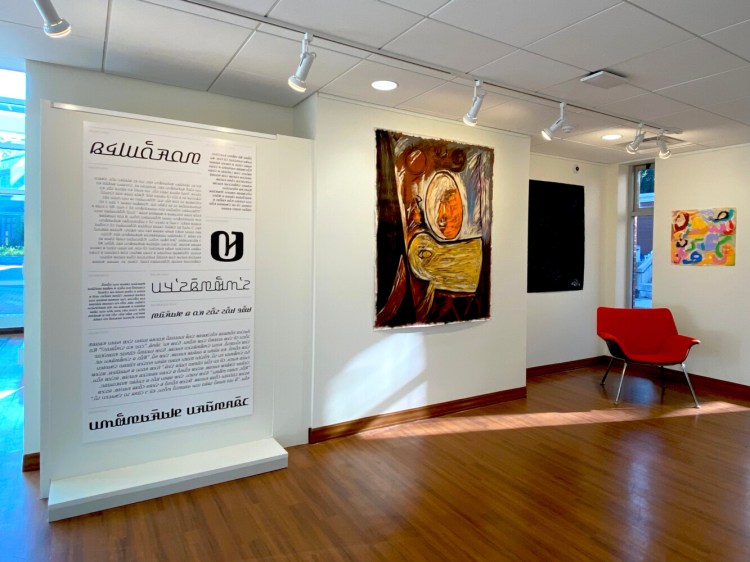BIDDEFORD — The connections in the Maine art world are many and layered. An exhibition at the University of New England Art Gallery at Ketchum Library on the Biddeford campus shows how those casual connections can lead to a groundbreaking exhibition.
On view until Jan. 7, “Alphabet City: Art, Culture, and Letterforms” features the paintings of Portland painter Kifah Abdulla, who uses Arabic calligraphy in gestural colorful abstract works, and the gestural graphic designs of Mark Jamra and Neil Patel of Portland-based Jamra Patel, whose Kigelia project resulted in a typeface family used across Africa.
Gallery director Hilary Irons knew Abdulla because she took an Arabic language class from him, then got to know him as a painter and poet. She knew Jamra through Maine College of Art + Design, where they both taught, then heard him and Patel talk about Kigelia project. When she later learned Jamra and Patel also had taken a language class from Abdulla, she proposed the exhibition because she saw how they connected through their interest in language and their use of written forms to express meaning.
“I thought the design work of Mark and Neil and the paintings of Kifah would work really well together. They have a lot in common, including a shared love of text,” Irons said.
The exhibition includes examples of the Jamra and Patel’s design work in black and white, and Abdulla’s paintings, which are fluid and colorful and generally large. Both use script as a form of expression – Jamra and Patel precisely, while Abdulla works more freely.

The sunlit gallery at Ketchum Library in Biddeford features paintings by Kifah Abdulla and design work by Mark Jamra and Neil Patel.
With language as a common trait, Irons was delighted to be able to hang the exhibition in the glass-walled gallery at the Ketchum Library. An exhibition about language, representation and identity belongs in a library for all to see, she said.
She credited her collaborator, Jarid del Deo, for the show’s installation. “It is set up in a way so the work is all in communication and conversation. It looks so lovely together in dialogue,” Irons said.
UNE operates a global studies program in Morocco, an Arabic-speaking country. “Many of the students who study abroad from UNE go to our campus in Morocco, where Arabic is spoken,” Irons said. “It made sense for UNE to host a show that honors the Arabic language tradition and recognizes the importance not only of Arabic but other languages that use non-Latin script. It is to me a very important collaborative experience, and I am so proud of the artists.”
Send questions/comments to the editors.




Comments are no longer available on this story